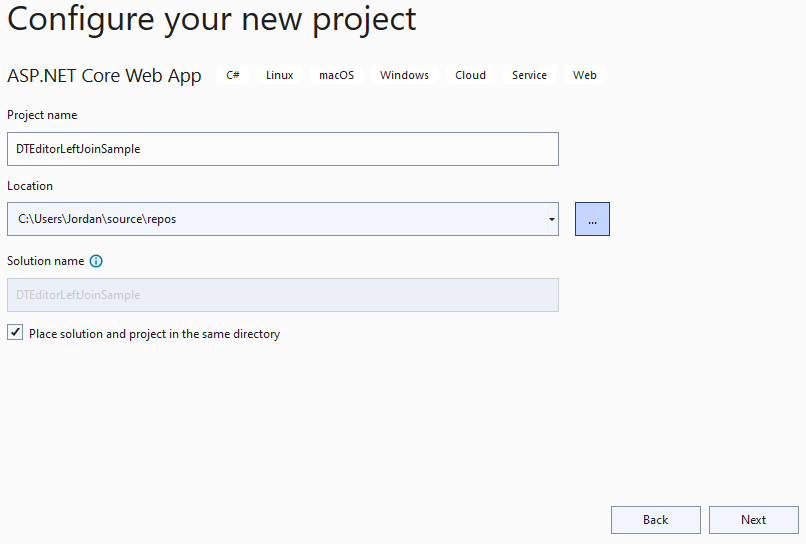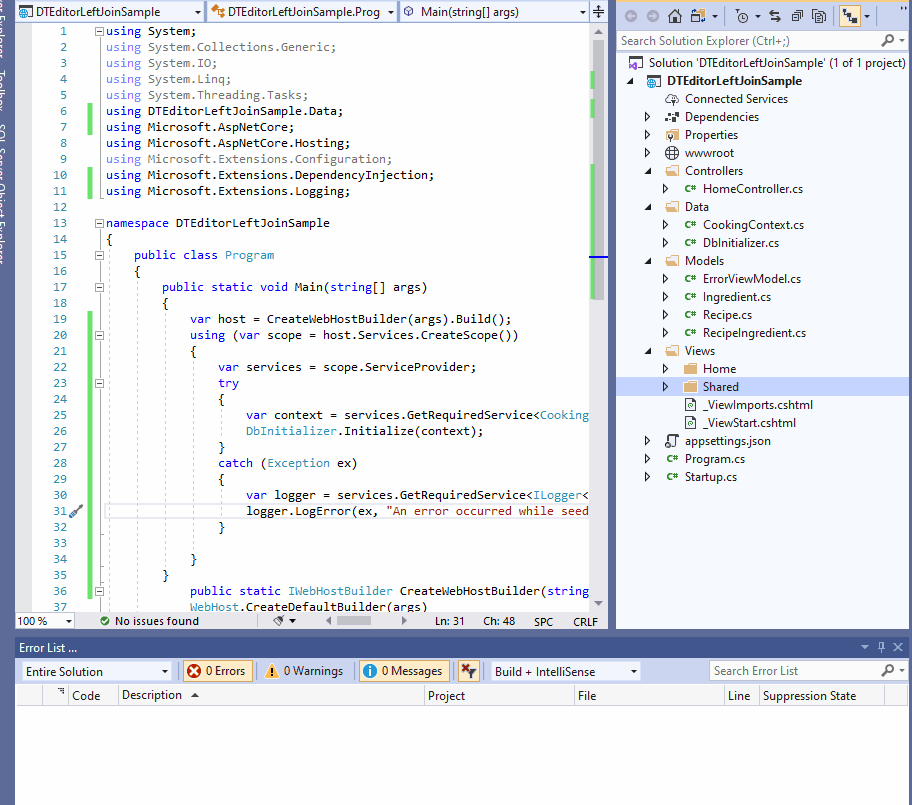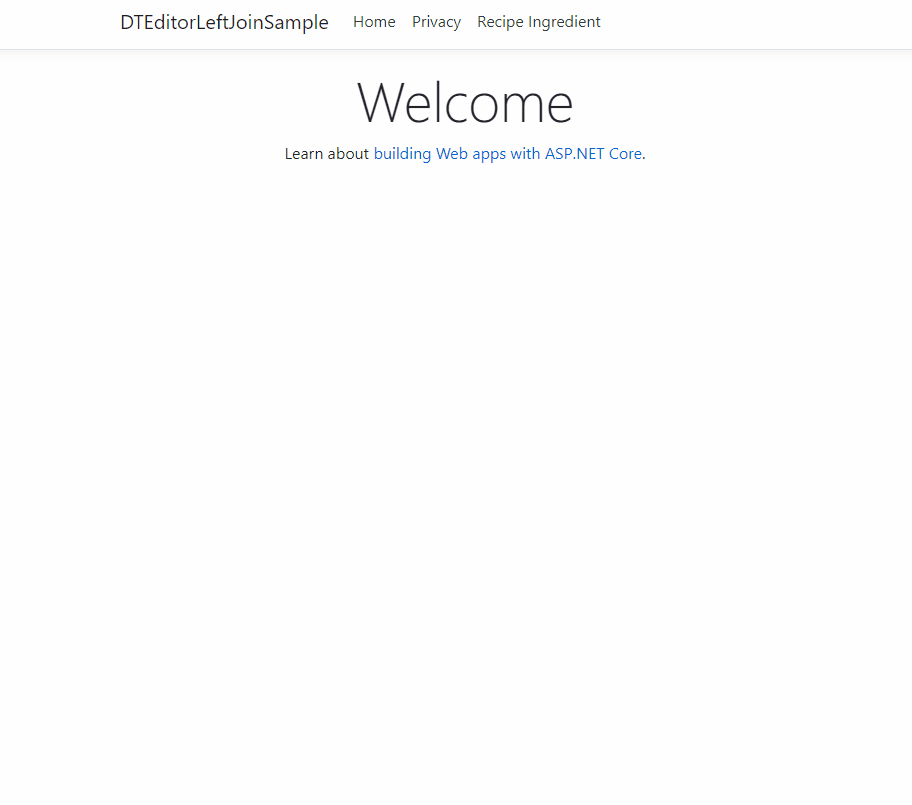How to retrieve data from related tables in DataTables with ASP.NET 6
Table of contents
- Download and setup .NET 6
- Create App In Visual Studio 2022
- Recipe
- RecipeIngredient
- Create Ingredient class
- Insert connection string into appsettings.json
- Create CookingContext
- Install Entity Framework Core and other packages
- Register CookingContext in Program.cs
- Create data seed
- Call context and seed method and register factory for DataTables
- Program.cs
- Generate controllers and views with scaffolding engine
- Add Recipeingredient To Navbar
Previously I showed you how to create an SQL Left Join using DataTables in ASP.NET 5 MVC Now that .NET 5 is no longer getting security updates it is time to upgrade to .NET 6, (not called .NET Core).
I have a completed demo which you can download here in .NET 6 . You can also go back through previous commits in the demo where I have listed the version it has upgraded to. You should know that I have methodically upgraded it from 2.2 to 3.0 and 3.1 to 5…
And now .NET 6. as that is how Microsoft have done it in their migration tutorial guides. The hard part was upgrading the project from 2.2 to 3.0. After that it’s a breeze!
Don’t worry I will show you how to build the project from scratch so you don’t have to migrate it from different frameworks.
If you know how to build an ASP.NET Core CRUD App please skip to here to learn how to integrate them with DataTables Editor.
Download and setup .NET 6
First check in the command line to see if you have .NET 6 already installed by typing cmd into the windows Start search bar to bring it up and then running the command dotnet --info.
If you see any 6.0 listed then you should be ok to skip to the next heading.
//.NET Core CLI output
.NET SDKs installed:
3.1.415 [C:\Program Files\dotnet\sdk]
5.0.209 [C:\Program Files\dotnet\sdk]
5.0.301 [C:\Program Files\dotnet\sdk]
5.0.303 [C:\Program Files\dotnet\sdk]
5.0.403 [C:\Program Files\dotnet\sdk]
6.0.100 [C:\Program Files\dotnet\sdk]
Not seeing it? Then go here download and install it, then use the same command to see if 6.0 is listed.
Create App In Visual Studio 2022
Microsoft’s ASP.NET team use Visual Studio for MVC tutorials with EF Core. So let’s first open Visual Studio 2022 and create ASP.NET WebApplication Template.
You can always play around with this app in VS Code later if you want once you complete it.

Make sure you have selected ASP.NET 6.0 (Long-term support) and have no authentication selected and have
configure for HTTPS selected as well.

After that create the project.

We will now create a Recipe database 3 different models, Recipe, RecipeIngredient and Ingredient. Create each of these classes in the model folder.
Recipe
namespace DTEditorLeftJoinSample.Models
{
public class Recipe
{
public int ID { get; set; }
public string Title {get;set;}
public string Description {get;set;}
public string Direction {get;set;}
public ICollection<RecipeIngredient> RecipeIngredient { get; set; }
}
}
RecipeIngredient
namespace DTEditorLeftJoinSample.Models
{
public class RecipeIngredient
{
public int ID { get; set; }
[Display(Name = "Recipe ID")]
public int RecipeID { get; set; }
[Display(Name = "Ingredient ID")]
public int IngredientID { get; set; }
public int Quantity { get; set; }
public Recipe Recipe { get; set; }
public Ingredient Ingredient { get; set; }
}
}
Create Ingredient class
namespace DTEditorLeftJoinSample.Models
{
public class Ingredient
{
public int ID { get; set; }
[Display(Name = "Ingredient Name")]
public string IngredientName { get; set; }
public ICollection<RecipeIngredient> RecipeIngredient { get; set; }
}
}
Insert connection string into appsettings.json
Create the connection string in appsettings.json then copy and paste this connection string there.
{
"ConnectionStrings": {
"DefaultConnection": "Server=(localdb)\\mssqllocaldb;Database=RecipeDB;Trusted_Connection=True;MultipleActiveResultSets=true"
},
"Logging": {
"LogLevel": {
"Default": "Warning"
}
},
"AllowedHosts": "*"
}
Create CookingContext
Even though we cannot integrate Entity Framework Core directly with DataTables Editor, we can still generate the database via EF Core to use with the library. We will do this by creating the database context class. Create a Data folder and add this class.
namespace DTEditorLeftJoinSample.Data
{
public class CookingContext : DbContext
{
public CookingContext(DbContextOptions<CookingContext> options) : base(options)
{
}
public DbSet<Recipe> Recipe { get; set; }
public DbSet<Ingredient> Ingredient { get; set; }
public DbSet<RecipeIngredient> RecipeIngredient { get; set; }
protected override void OnModelCreating(ModelBuilder modelBuilder)
{
modelBuilder.Entity<Recipe>().ToTable("tblRecipe");
modelBuilder.Entity<Ingredient>().ToTable("tblIngredient");
modelBuilder.Entity<RecipeIngredient>().ToTable("tblRecipeIngredient ");
}
}
}
Install Entity Framework Core and other packages
Go to the bottom of the screen and to the Developer PowerShell. Enter the following commands to install the required packages for this tutorial. The directory path should be pointing to the application already unless you changed directories in the PowerShell.
dotnet add package Microsoft.EntityFrameworkCore --version 6.0.0
dotnet add package Microsoft.AspNetCore.Mvc.NewtonsoftJson --version 6.0.0
dotnet add package Microsoft.EntityFrameworkCore.Design --version 6.0.0
dotnet add package Microsoft.EntityFrameworkCore.SqlServer --version 6.0.0
dotnet add package Microsoft.VisualStudio.Web.CodeGeneration.Design --version 6.0.0
The errors in CookingContext.cs and in Startup.cs should disappear.
Register CookingContext in Program.cs
Register the CookingContext as a service in Program using dependency injection. You can do that by adding this code to the Program.cs including Newtonsoft.Json features so we can use json on the client side.
// Add services to the container.
builder.Services.AddControllersWithViews();
builder.Services.AddDbContext<CookingContext>(options =>
options.UseSqlServer(builder.Configuration.GetConnectionString("DefaultConnection")));
builder.Services.AddControllers().AddNewtonsoftJson();
builder.Services.AddControllersWithViews();
Create data seed
Now we want to seed the database with test data. This is an optional step but highly beneficial. If it does not work for you, the data can be entered manually. In the Data folder create this file DbInitializer.cs and insert this code.
namespace DTEditorLeftJoinSample.Data
{
public static class DbInitializer
{
public static void Initialize(CookingContext context)
{
context.Database.EnsureCreated();
// Look for any tables.
if (context.Recipe.Any() && context.Ingredient.Any() && context.RecipeIngredient.Any())
{
return; // DB has been seeded
}
var recipes = new Recipe[]
{
new Recipe { Title =" Korean-Style Steak and Noodles with Kimchi",
Description="Lorem ipsum dolor sit amet, consectetur adipiscing elit. Praesent sed pharetra neque. Curabitur laoreet eu lectus eu tempus. Fusce elementum arcu ut justo tincidunt mattis.",
Direction="1.Cras dignissim in neque a placerat." + "\r\n" + "2.Vestibulum vel vestibulum nunc." + "\r\n" + "3. Vestibulum interdum est tellus, nec porta metus dignissim ut."
},
new Recipe { Title =" Mashed Potatoes with Savory Thyme Granola",
Description=" Etiam aliquam, magna quis lobortis facilisis, lorem eros dignissim nulla, ultrices pulvinar orci lectus a ligula.",
Direction="1. Morbi fringilla, justo eu venenatis tempus, mauris leo ultricies magna, et aliquet mi lectus at nisi. Pellentesque vel gravida nunc. Donec in tortor lectus." + "\r\n" + "2.Vestibulum vel vestibulum nunc." + "\r\n" + "3. Vestibulum interdum est tellus, nec porta metus dignissim ut."},
new Recipe { Title ="Lemon Garlic Mashed Potatoes",
Description="Pellentesque habitant morbi tristique senectus et netus et malesuada fames ac turpis egestas.",
Direction="1. Maecenas ultricies pretium quam id placerat. Mauris in ligula gravida, vehicula justo faucibus, semper neque." + "\r\n" + "2. Proin sodales aliquam erat quis venenatis." + "\r\n" + "3. Morbi consectetur libero id sagittis vestibulum."},
new Recipe { Title =" Sour Cream and Corn Mashers",
Description=" Donec posuere pellentesque mi, ac suscipit tellus finibus id.",
Direction="1. Nulla placerat erat lorem, eget pellentesque dolor egestas vitae." + "\r\n" + "2. Proin sodales aliquam erat quis venenatis." + "\r\n" + "3. Suspendisse ac purus lacinia, mollis velit aliquet, finibus arcu. Pellentesque molestie est in diam pulvinar, quis mattis justo volutpat."}
};
foreach (Recipe r in recipes)
{
context.Recipe.AddRange(r);
}
context.SaveChanges();
var ingredients = new Ingredient[]
{
new Ingredient{IngredientName="Duis eu ligula felis"},
new Ingredient{IngredientName="Donec id mollis arcu"},
new Ingredient{IngredientName="Cras nec enim luctus"}
};
foreach (Ingredient i in ingredients)
{
context.Ingredient.AddRange(i);
}
context.SaveChanges();
var recipeIngredients = new RecipeIngredient[]
{
new RecipeIngredient{RecipeID=1, IngredientID=1, Quantity =4},
new RecipeIngredient{RecipeID=2, IngredientID=2, Quantity =3},
new RecipeIngredient{RecipeID=3, IngredientID=3, Quantity =15}
};
foreach (RecipeIngredient ri in recipeIngredients)
{
context.RecipeIngredient.AddRange(ri);
}
context.SaveChanges();
}
}
}
We want to get the database context instance from dependency injection container.
Call context and seed method and register factory for DataTables
Now we call the context instance, the seed method and pass it to the context. Then dispose the context when the seeding is complete. In
Program.cs delete any code in the Main method and add this all to the method.
To use DataTables also we must register the database driver which is System.Data.SqlClient. We will do it all in Program.cs and also log any exceptions to do with seeding the database.
Program.cs
using (var scope = app.Services.CreateScope())
{
var services = scope.ServiceProvider;
var context = services.GetRequiredService<CookingContext>();
context.Database.EnsureCreated();
DbInitializer.Initialize(context);
}
It is immperative that you write this and any over code above app.Run else C# will ignore any code below it upon compliling.
Now in the Data folder add a empty .cs file called GlobalNamespaces.cs delete anything inside the file and copy and paste this into it.
global using DTEditorLeftJoinSample.Models;
global using Microsoft.EntityFrameworkCore;
global using System.ComponentModel.DataAnnotations;
global using DTEditorLeftJoinSample.Data;
global using Microsoft.AspNetCore.Builder;
global using Microsoft.Extensions.DependencyInjection;
global using Microsoft.Extensions.Configuration;
global using Microsoft.Extensions.Hosting;
global using System.Collections.Generic;
global using System.Linq;
global using System.Data.Common;
global using Microsoft.Data.SqlClient;
global using System.Threading.Tasks;
global using Microsoft.AspNetCore.Mvc;
global using Microsoft.AspNetCore.Mvc.Rendering;
Goodbye repetitive namespaces. C# 10 gives us the ability to minimize all the code files containing namespaces by centralizing them all into one file throughout our entire application.
Generate controllers and views with scaffolding engine
The scafolding engine on Windows CLI still has problems so we will have to use Visual Studio’s GUI to access the scaffolding engine and generate the items.
Rather than write it manually it is easier to first auto generate all the CRUD view pages and controllers using Entity Framework Core from the models we made and edit the pages later. We will generate in the scaffolding engine. To that:
- Right-click the Controllers folder in Solution Explorer and select Add > New Scaffolded Item
- In the Add Scaffold dialog box:
- Select MVC controller with views, using Entity Framework.
- Click Add. The Add MVC Controller with views, using Entity Framework dialog box appears.
- In Model class select RecipeIngredient.
- In Data context class select CookingContext.
- Accept the default CookingController as the name.
- Click Add. The Add MVC Controller with views, using Entity Framework dialog box appears.

If all is ok then the RecipeIngredient folder generates with all the views, Index, Edit, Details, Delete. Notice in the Controllers folder the new generated controller RecipeIngredientsController.cs.
I would like to note if you are getting painfully unclear errors like this:
There was an error running the selected code generator.
Package restore failed. Rolling back package...
It’s highly likely you need to update all packages to the latest version in .NET 6. That’s what helped me. I originally wrote this blog for .NET 3.1 Core and had problems generating the controllers and views in the VS Code CLI. Going to Visual Studio didn’t help either so I migrated to the latest version which helped.
Add Recipeingredient To Navbar
We want to be able to go the form in our _layout.cshtml file. In the second div tag of the header add this list item to the navbar.
<li class="nav-item">
<a class="nav-link text-dark" asp-area="" asp-controller="RecipeIngredients" asp-action="Index">Recipe Ingredient</a>
</li>
Now we got to add the migrations and update the database before we can run it. Enter this into our PowerShell.
dotnet ef migrations add InitialCreate
dotnet ef database update
You may have to update the to update the global tools to the latest available version if these commands do not work, which at the time is 6.0.0.
dotnet tool update --global dotnet-ef
Press F5. Running the program will generate the database and fill out the tables. If it doesn’t work please use the SQL Server Object Explorer to fill the tables manually.
If all goes well you should be able to go directly to the table in the Index view and render the project. But as I said there is no sorting, paging and searching. Not only that, we want to render the RecipeTitle and the IngredientName fields from the other tables not the foreign key IDs!

Now that we have set up our project in .NET 6 it is time to setup DataTables. Join me in the next blog in part 2 where we do this.